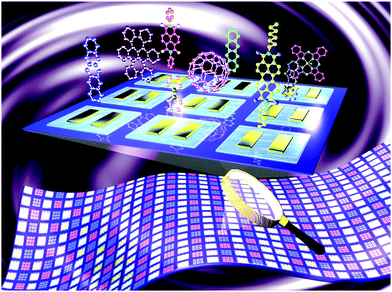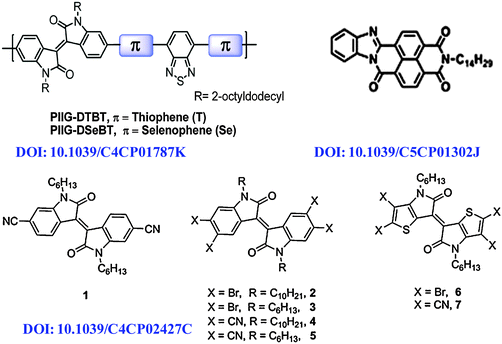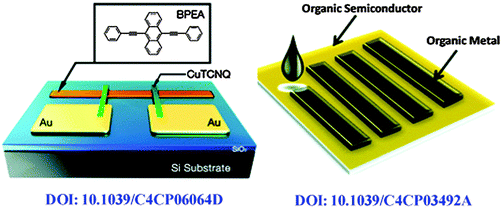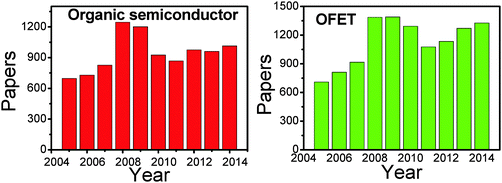Themed issue on “Organic field-effect transistors: interfacial phenomena and electronic properties”
K.
Krishnamoorthy
a,
Antonio F.
Facchetti
b,
Wenping
Hu
c and
Zhenan
Bao
d
aCSIR-National Chemical Laboratory, Pune 411008, India
bPolyera Corporation and Northwest University, IL 60208, USA
cInstitute of Chemistry, Chinese Academy of Sciences, Beijing 100190, China
dStanford University, CA 94305-4125, USA
 K. Krishnamoorthy |
 Antonio F. Facchetti |
 Wenping Hu |
 Zhenan Bao |
Over the past two decades, organic field-effect transistors (OFETs), as the key and fundamental element of organic electronics, have attracted a great deal of interest due to their unique features of solution processability, flexibility and wearability. Moreover, due to their capability for insight into the charge transport of π-conjugated systems, OFETs act as strong tools for the exploration of structure–property relationships of π-conjugated systems. Since the discovery of OFETs in the late 1980s, they have attracted particular attention and progressed rapidly. Research includes the discovery, design and synthesis of π-conjugated systems for OFETs, device fabrication techniques and processing engineering, their applications in radio-frequency identification (RFID) tags, flexible displays, electronic papers, sensors, electronic skins and wearable devices and so forth (Fig. 1). OFETs are a kind of highly interdisciplinary device, closely related to chemistry, physics, materials science, electronics and microelectronics, and their applications are not limited only to novel electronics, but even extend into bio- and life science. The advancements of OFETs will generate new materials, concepts, models, theories and technologies for organic electronics. In this themed issue, organic field-effect transistors: interfacial phenomena and electronic properties will be the focus.
 | ||
| Fig. 1 OFETs research on materials for OFETs, device physics and processes, and device integrated for device arrays and organic circuits. | ||
Physical chemistry insight into OFETs includes the ability that the chemists have to modulate nearly at will the physical properties of organic (macro)molecules by fine-tuning their chemical structure, which constitutes another driver that boosts research and industrial interest in OFETs. Moreover, the factors dominating the performance of the transistors such as the grain boundaries, morphology, interfaces and crystallization, the way of ordering organic semiconductor molecules and the alignment of the energy levels of organic semiconductors and electrodes for the fabrication of high performance transistors, and the new fabrication techniques all point to physical chemistry and orient the application of OFETs. The special issue is highly refined on these aspects, being summarized simply as semiconductor physical chemistry, morphology and interface engineering and OFET integration for application.
As shown in Scheme 1, Yang et al. presented two new polymers of poly(isoindigo-alt-benzothiadiazole) (PIIG-DTBT and PIIG-DSeBT) involving IIG and BT blocks constructed using five-membered heteroaromatic spacers such as thiophene (T) and selenophene (Se) and investigated the effects of the spacer groups on the optical, electrochemical, and charge-transport properties (DOI: 10.1039/C4CP01787K). Hu et al. presented a new naphthalene diimide (NDI) derivative with an asymmetric aromatic backbone, which exhibited a low LUMO level, large energy gap, high thermal stability and typical n-type behavior with a mobility of 0.22 cm2 V−1 s−1 (DOI: 10.1039/C5CP01302J). Marder et al. reported several novel tetracyano isoindigo small molecules. All cyano derivatives operate in n-channel OFETs, while the tetrabromothienoisoindigo derivative functions in a p-channel transistor (DOI: 10.1039/C4CP02427C).
 | ||
| Scheme 1 The molecular structures of novel synthesized semiconducting materials for OFETs in this issue. | ||
Briseno controlled integration of oligo- and polythiophenes at the molecular scale successfully. They blended high molecular weight polymer with small molecules to enhance intergrain connectivity and charge transport. Analysis of the morphology and crystallinity of the blends shows that the polymer and oligomer are well-integrated, leading to high hole mobilities (DOI: 10.1039/C4CP02944E). Hümmelgen reported an attractive way to improve the performance of OFETs based on poly(3-hexylthiophene-2,5-diyl) (P3HT) with crosslinked poly(vinyl alcohol) (cr-PVA) as a gate insulator, through the treatment of the cr-PVA film surface before P3HT deposition with a cationic surfactant, hexadecyltrimethylammonium bromide (CTAB), leading to a tenfold increase in the charge carrier field-effect mobility (DOI: 10.1039/C4CP02245A).
Noda et al. carried out an experimental and numerical investigation on contact-area-limited doping for top-contact pentacene thin-film transistors with a Schottky contact, suggesting that both the contact-area-limited doping and the device simulation dealing with the Schottky contact are indispensable in designing and developing high-performance organic thin-film transistors (DOI: 10.1039/C4CP01792G). Very similar studies on organic metal electrodes were launched by Hu (DOI: 10.1039/C4CP06064D) and Mas-Torrent (DOI: 10.1039/C4CP03492A) and their co-workers. Hu et al. found by using the charge transfer complex CuTCNQ as the electrodes, the energy alignment between the organic semiconductors and CuTCNQ electrodes resulted in low energy barriers and contact resistance leading to efficient charge injection. Moreover, the metal electrodes of CuTCNQ provide intimate contact between organic semiconductors and electrodes, resulting in a potential improvement of morphology. In the Mas-Torrent perspective paper, an overview of the recent work devoted to the fabrication of OFETs with organic metals as electrodes are summarized. It will be shown that in these devices not only is the matching of the HOMO or LUMO of the semiconductor with the metal work-function important, but other aspects such as the interface morphology can also play a critical role (Fig. 2).
 | ||
| Fig. 2 OFETs with organic metals as the source and drain electrodes for device performance improvement. | ||
In the final article of this themed collection, Noh et al. highlighted challenges to the realization of high-performance OFETs and integrated circuits (ICs) using printing technologies. Unlike many other studies in the literature that deal with organic semiconductors, printing technology and device physics, Noh et al. commenced with a detailed examination of OFET performance parameters (e.g., carrier mobility, threshold voltage, and contact resistance) by which the related challenges and potential solutions to performance development are inspected. And they analyzed the performance of various organic ICs and discussed ways to optimize OFET characteristics and thus develop high-performance printed ICs for broad practical applications (DOI: 10.1039/C4CP02413C).
As an exciting research field with many potential practical applications, organic electronics is progressing extremely rapidly. For example, using “organic semiconductor” and “organic transistor” as the keywords in the paper title to search the Web of Science, it is possible to show the distributions of papers over recent years as shown in Fig. 3. It is very clear that the number of papers concerning organic electronics has increased quickly since 2005, indicating that it is a current hot research topic.
The aim of this current themed issue focuses on organic field-effect transistors: interfacial phenomena and electronic properties. As a highly interdisciplinary science, the research and development of OFETs continually derives ideas, methods, and technologies from other research fields. The breadth of this issue is evident from the diversity of the papers contributed by the leading scientists in this field. It was our great pleasure to cooperate with such outstanding scientists. Finally, we want to express our gratitude to all editorial members of PCCP, especially to Dr Colin King, for his great contribution and patience during the publication of the themed issue.
| This journal is © the Owner Societies 2015 |

